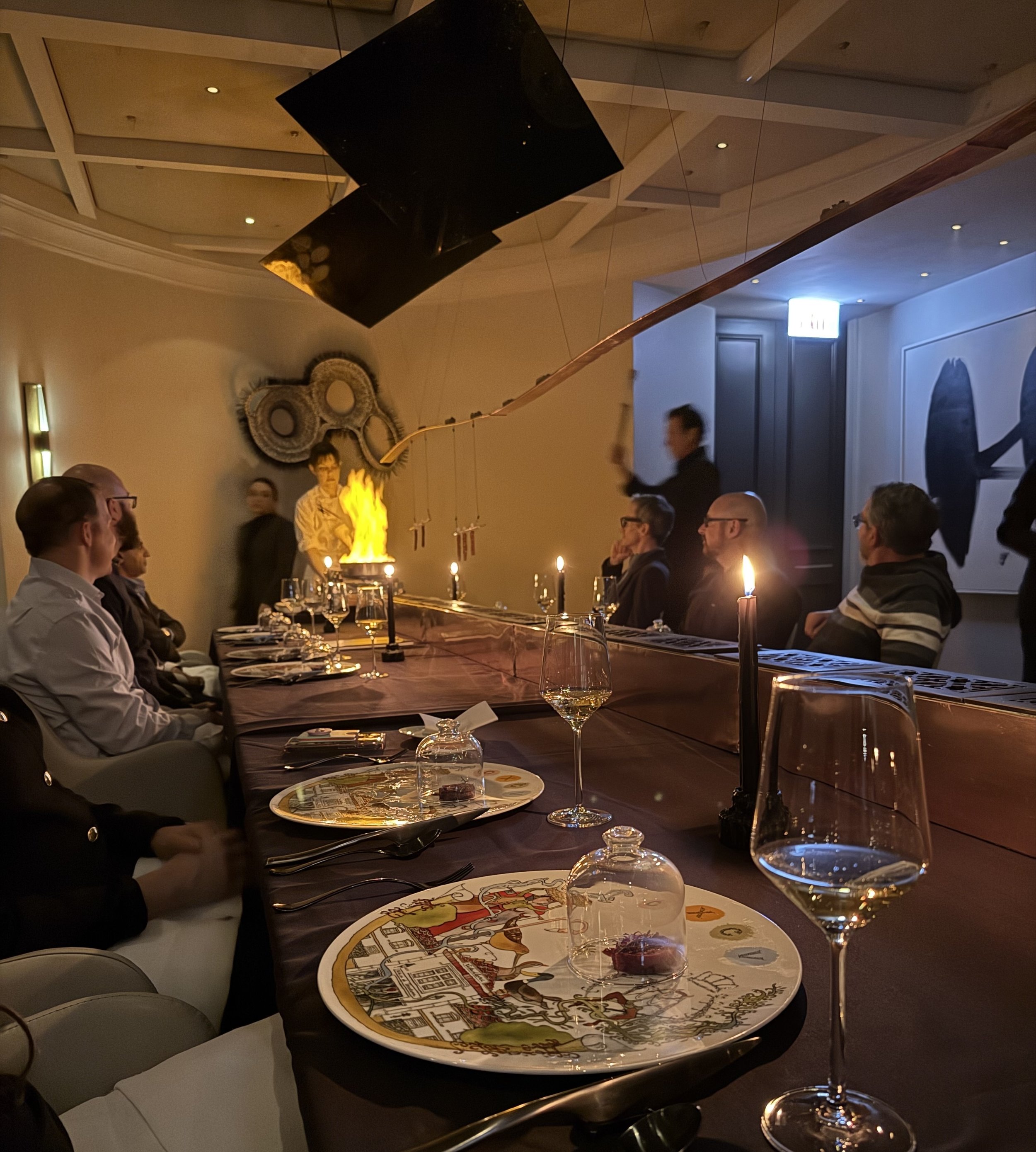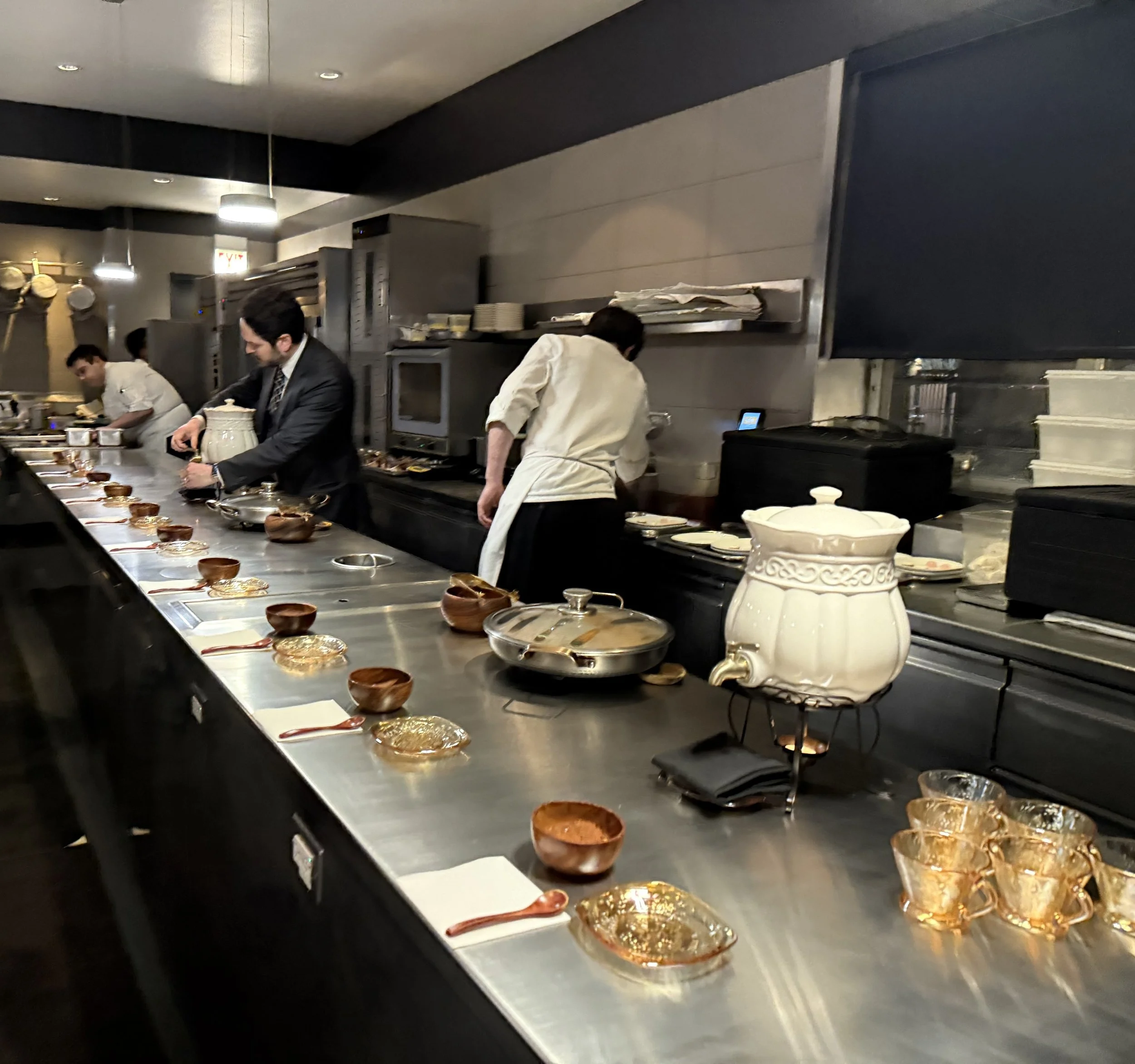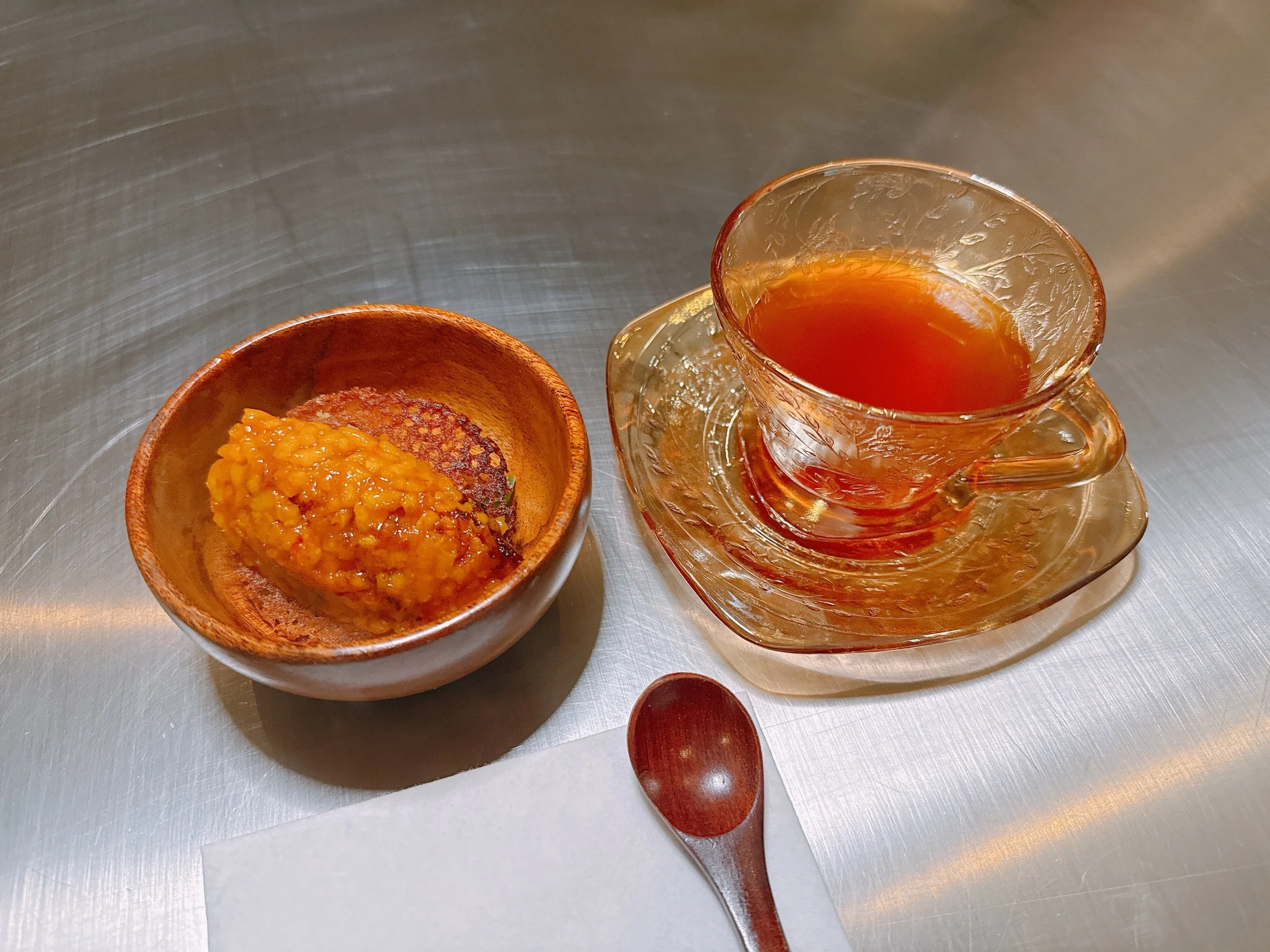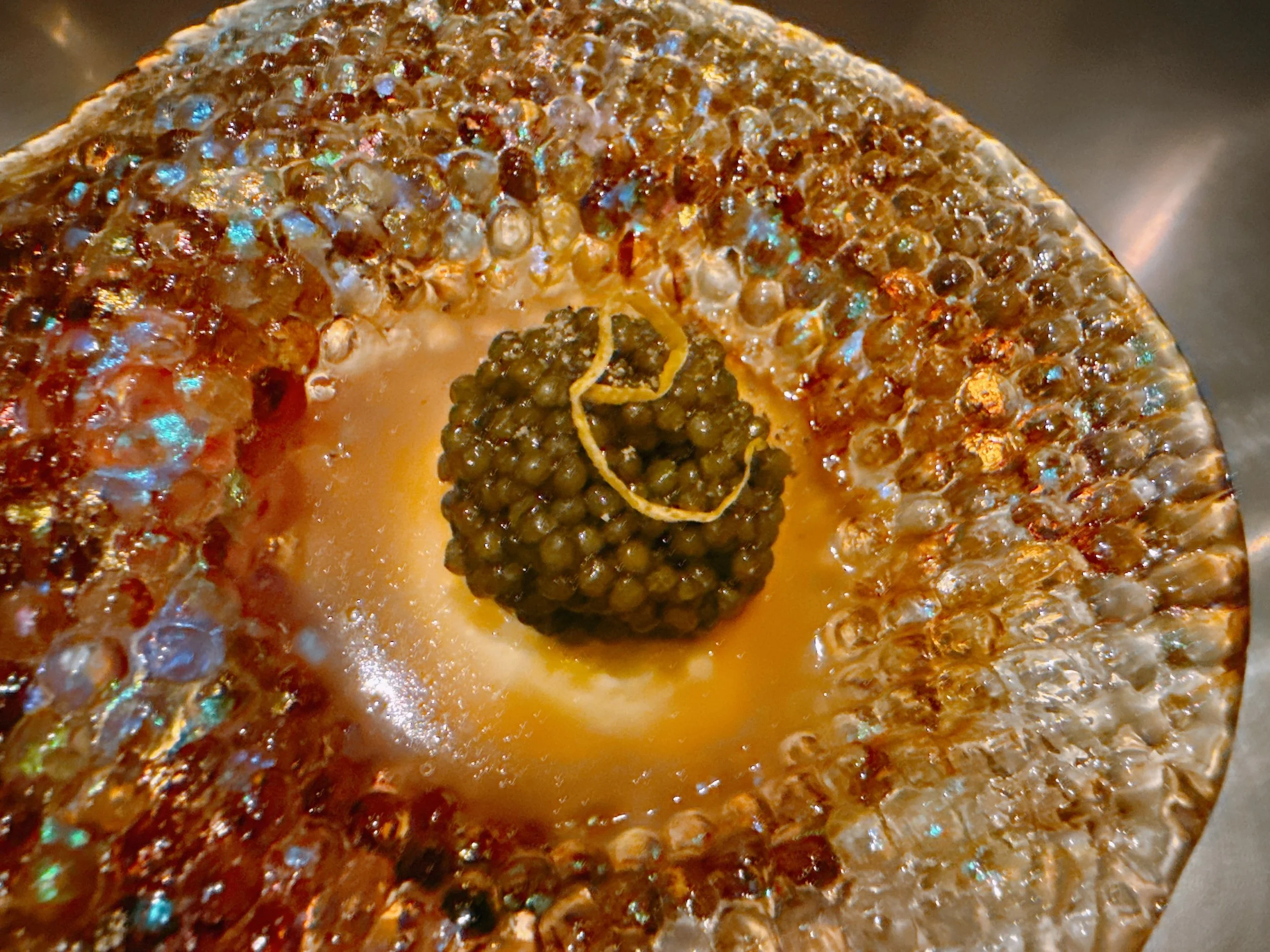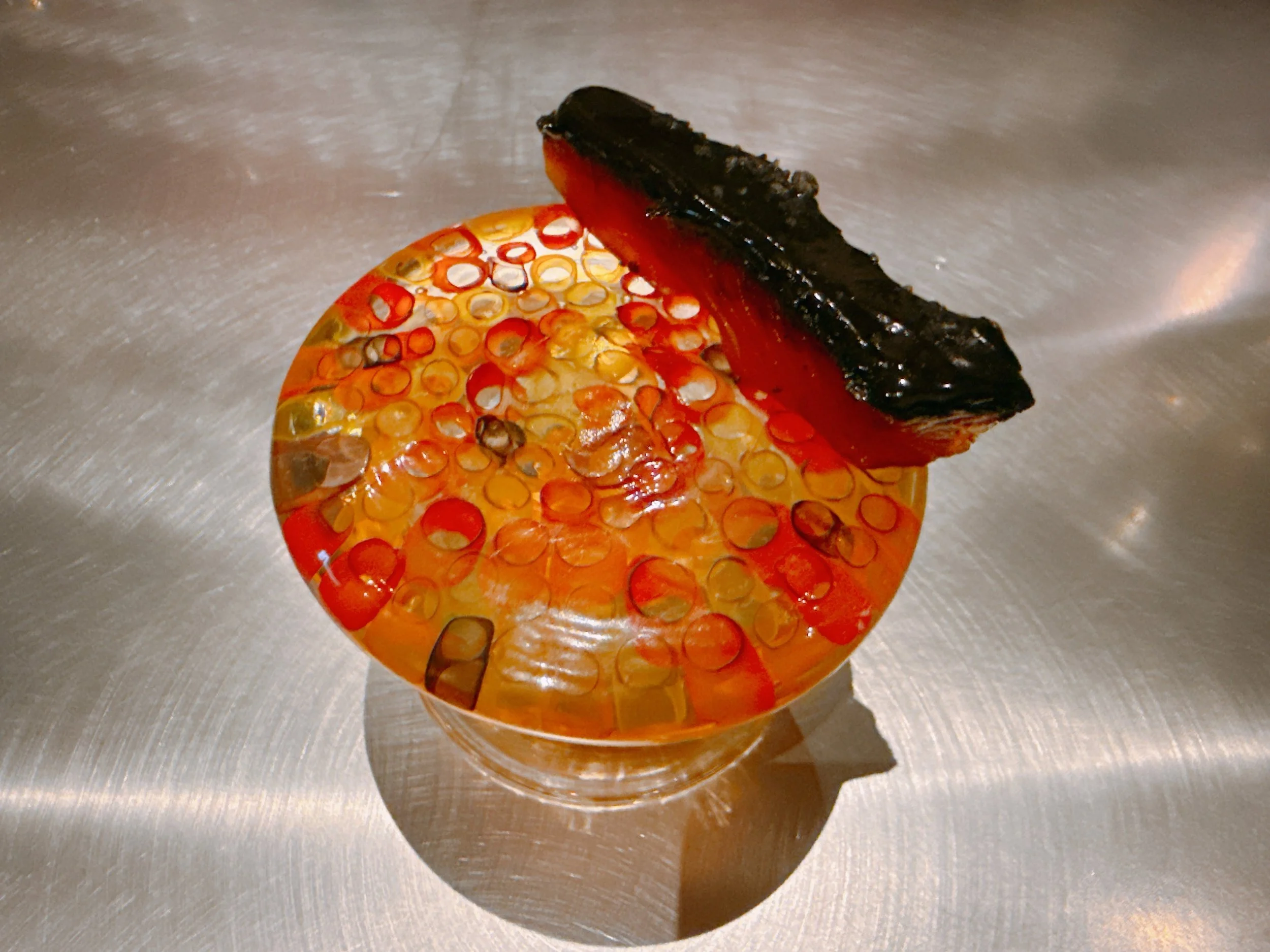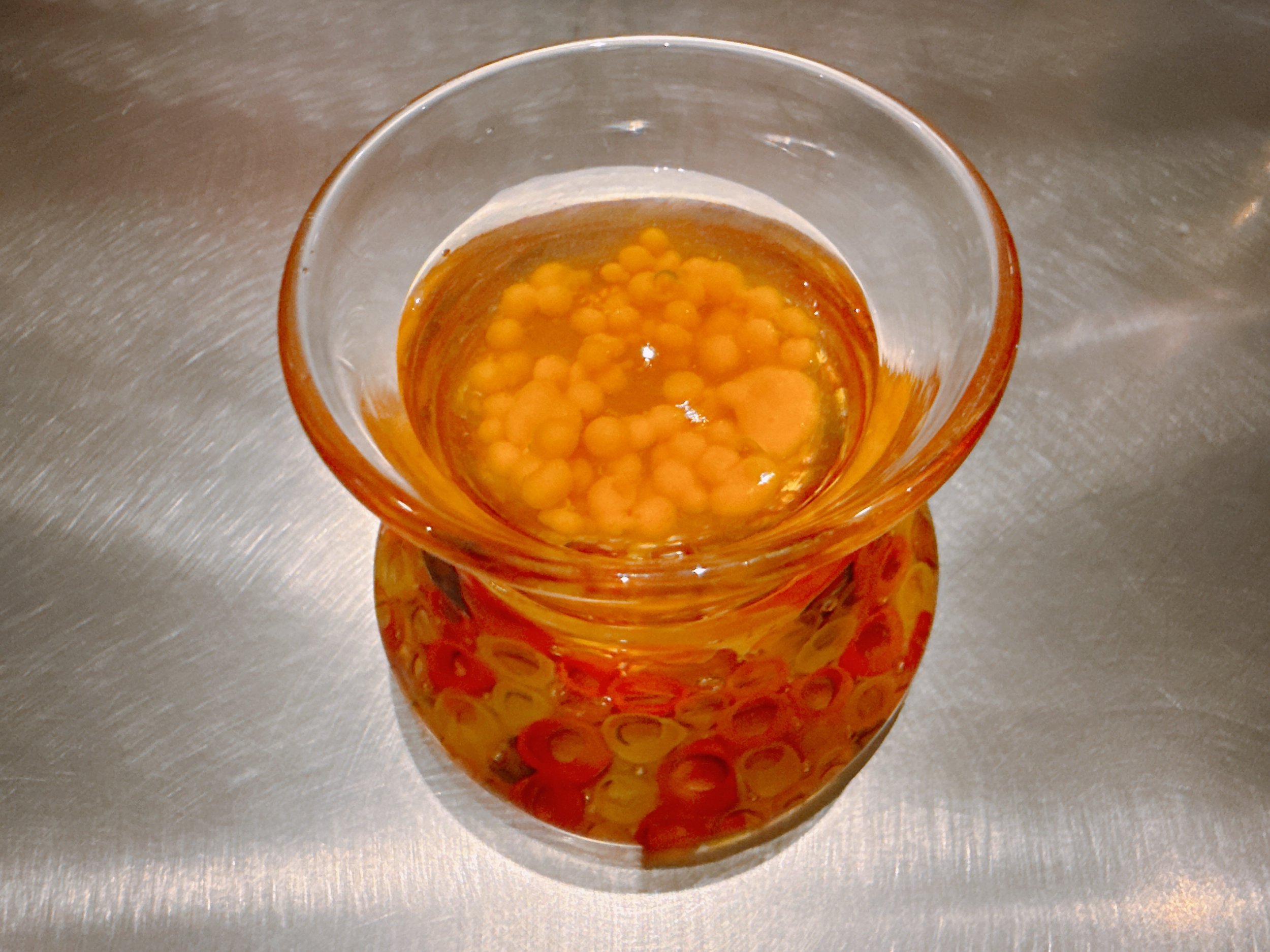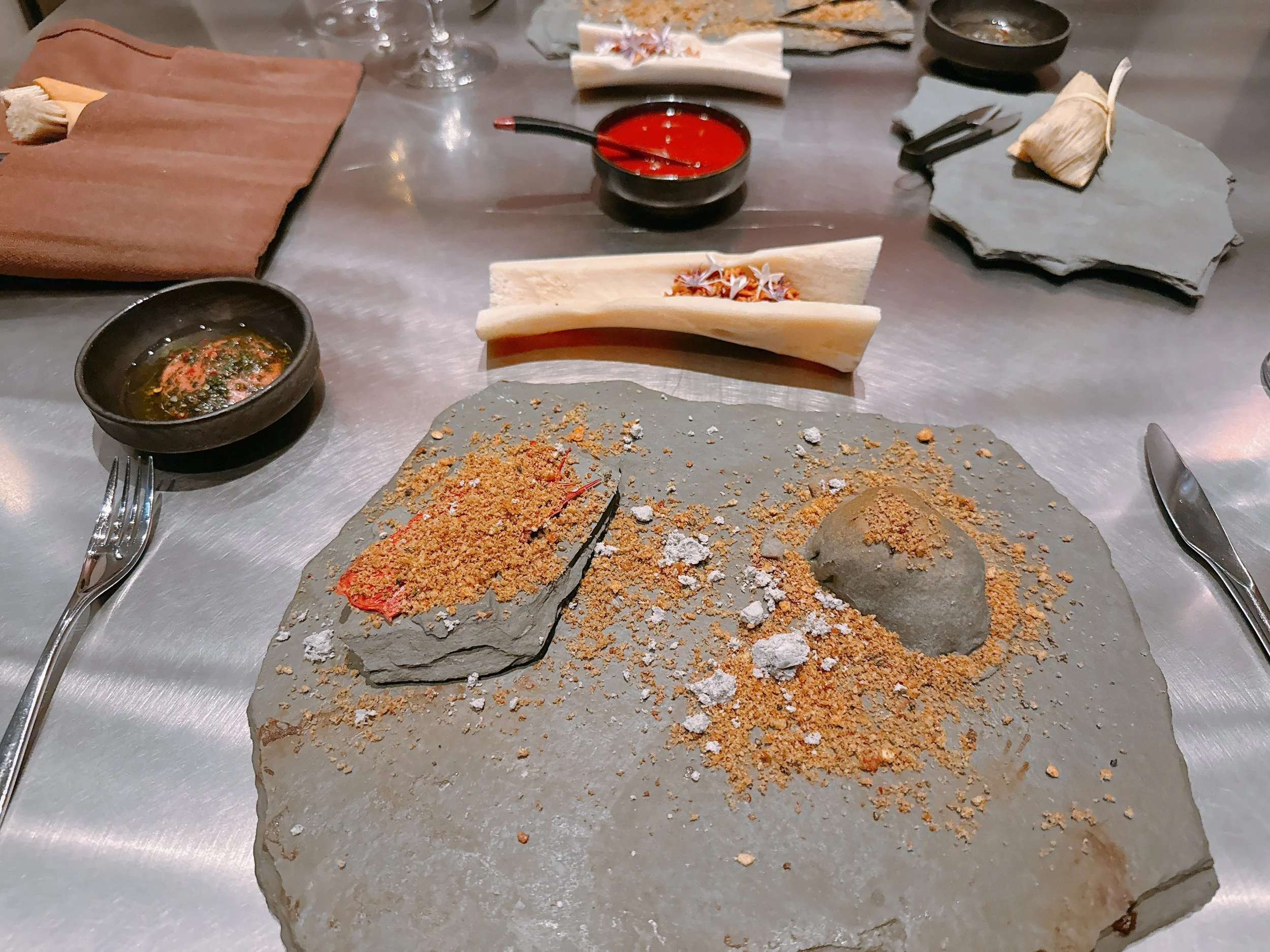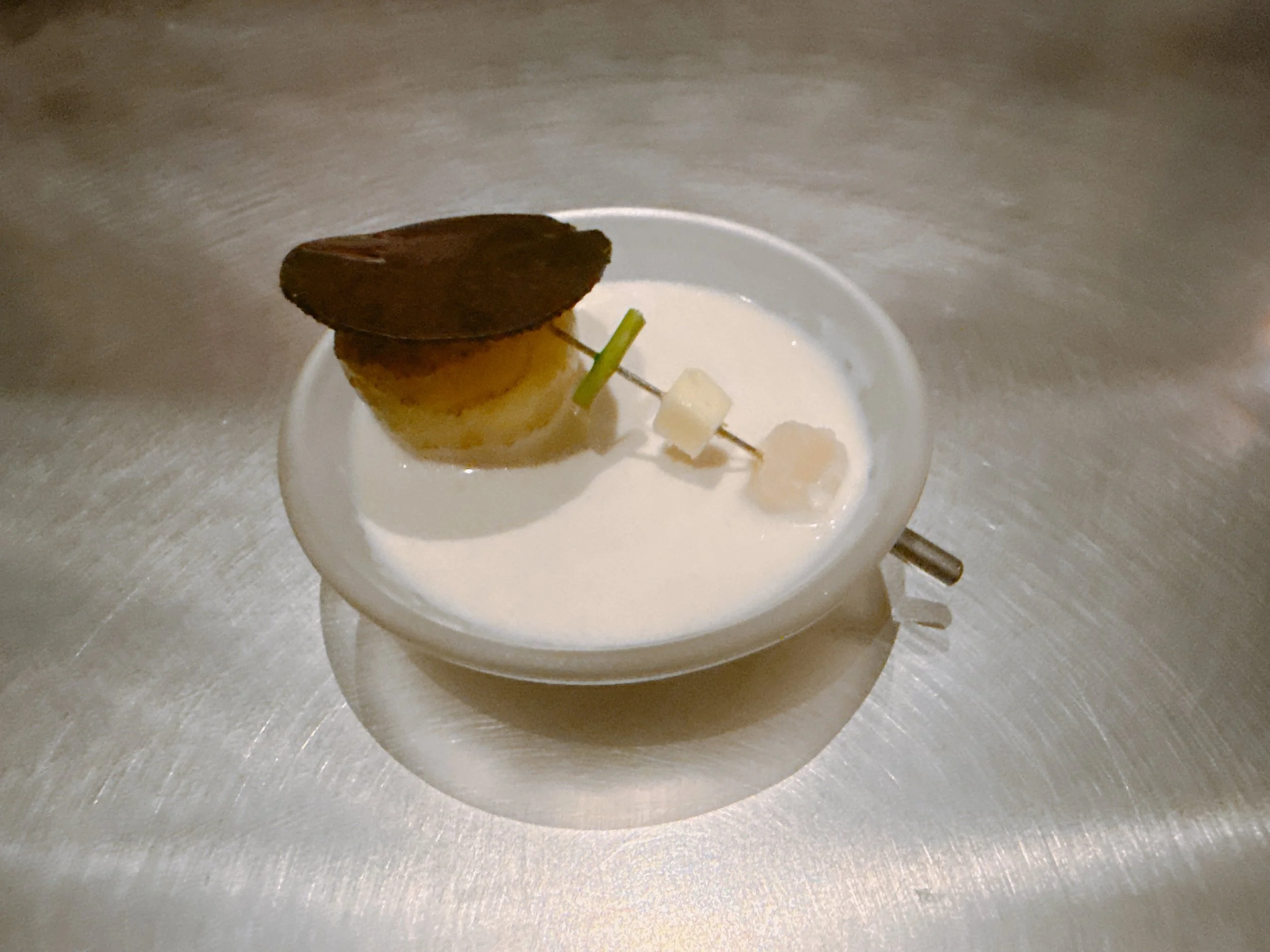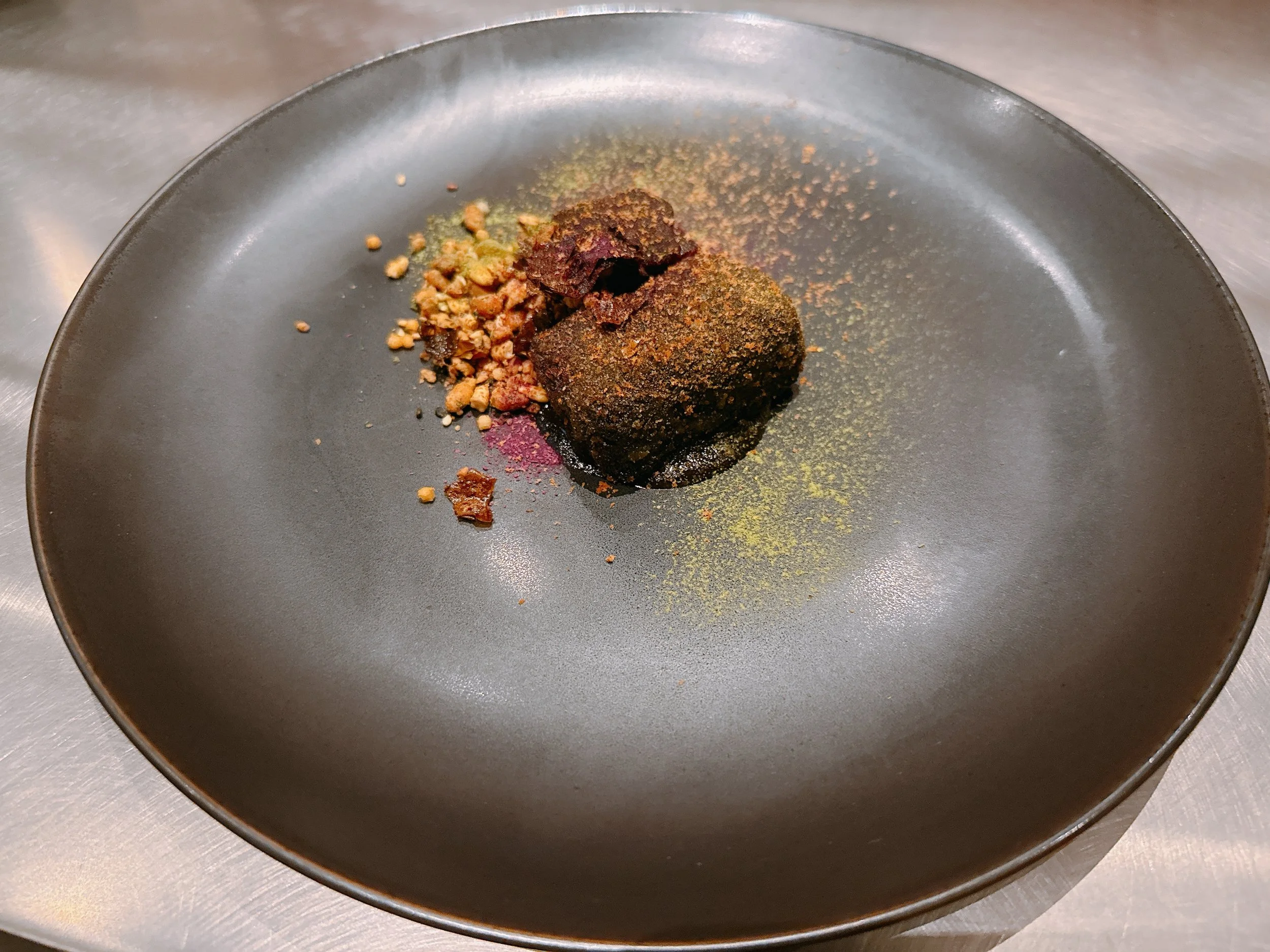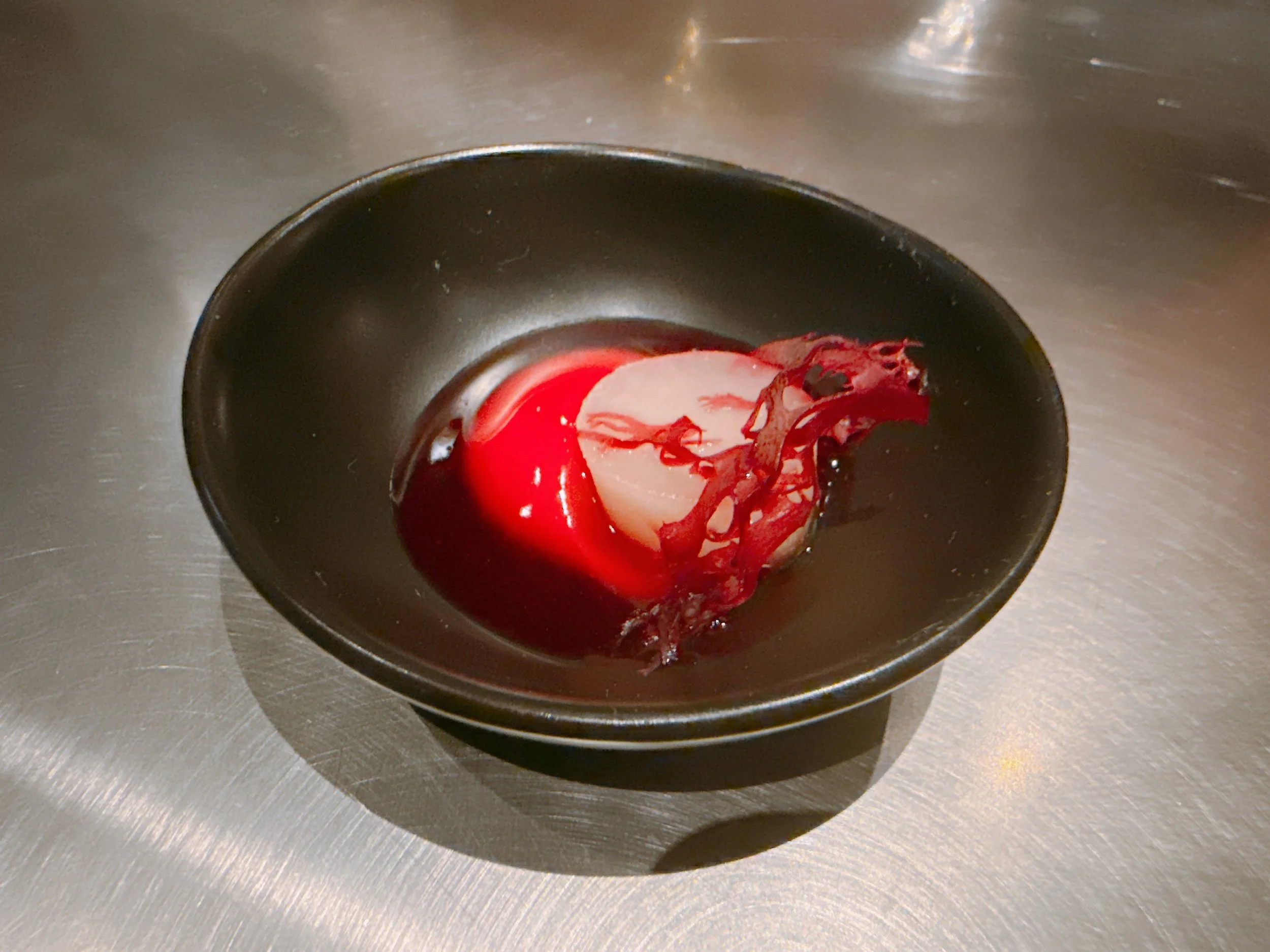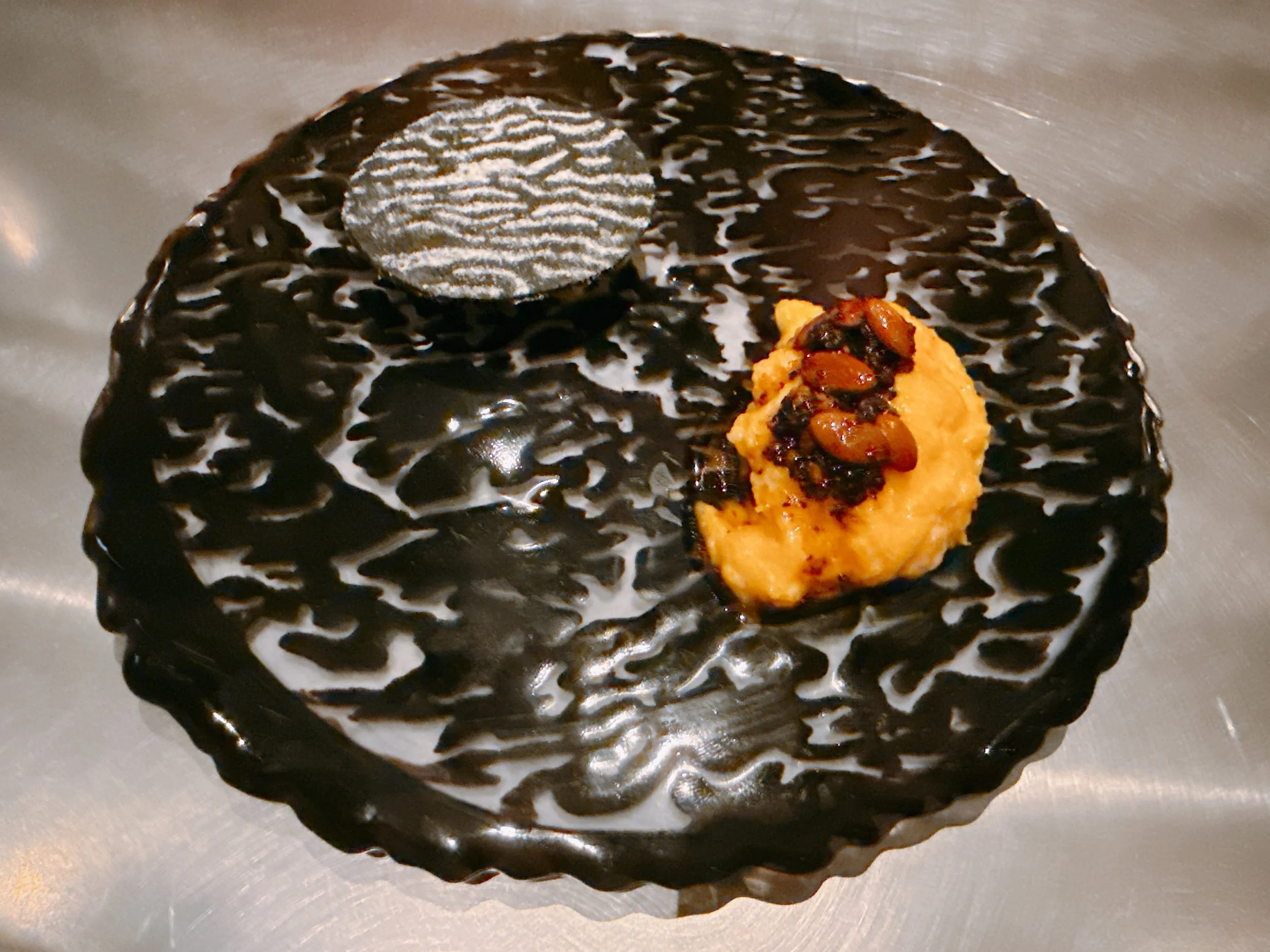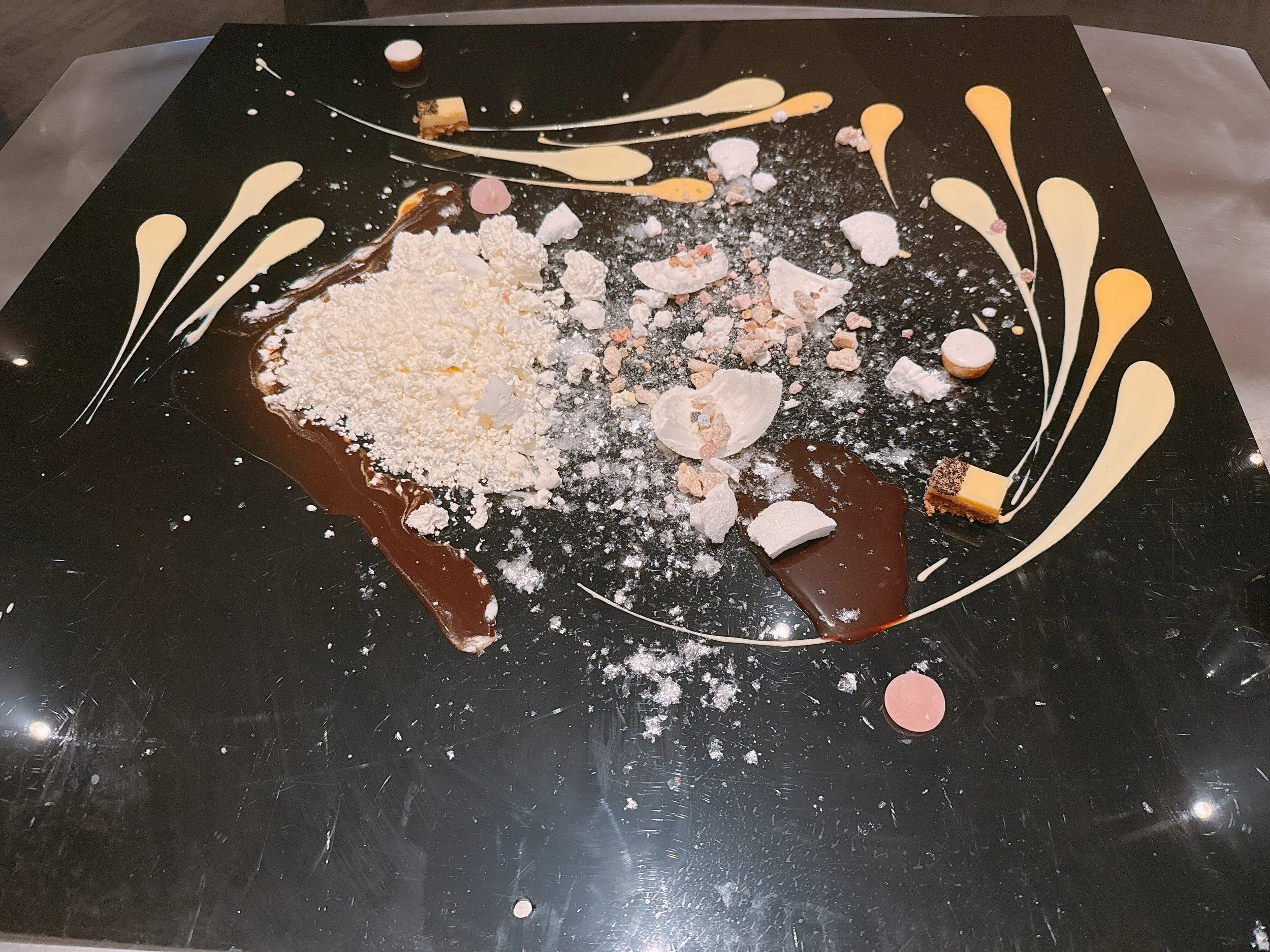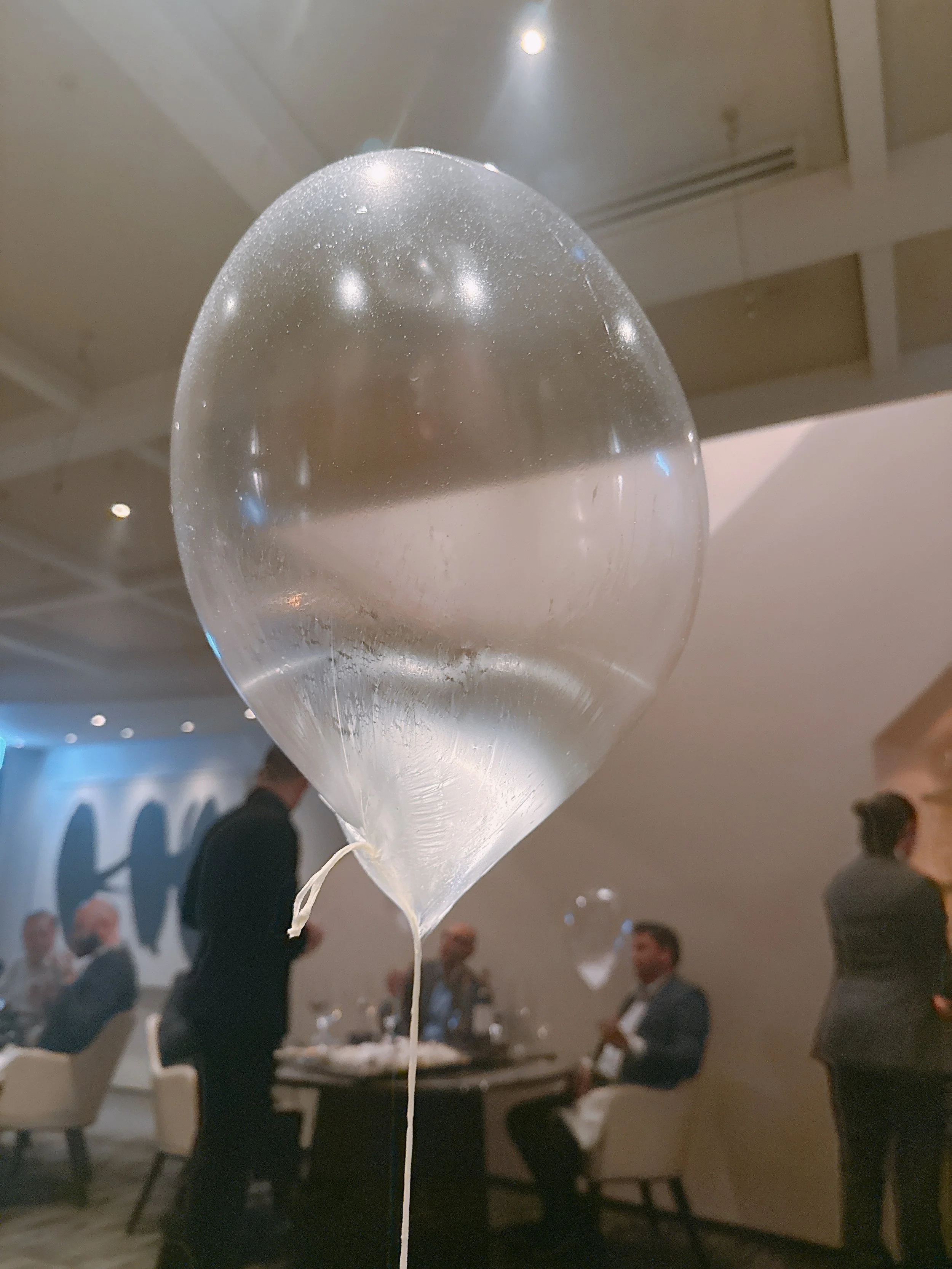Alinea - Chicago
Rating: 16/20
Where: Chicago, IL
When: Dinner for 2 on 9 April 2025
Cost per Person: Tasting menu $325-$495, Wine pairing $155-$395
Accolades: 3 Michelin Stars (2011-2024)
Why: Playful presentations; an “experience” rather than “just” a dinner
Spoiler alert: A dinner at Alinea has some performative aspects. If you want them to be a surprise, then reading the following is not recommended.
My first three visits to Chicago's Alinea from 2007-2010 are still among my favorite dining experiences ever. Each time, we were served twenty-four wildly inventive and utterly delicious courses. And against all odds, every meal was better than the one before. So when the first Michelin Guide for Chicago came out, it was no huge surprise that Alinea earned three stars right off the bat.
Our next visit in 2015 was somewhat disappointing, though. The menu had been shortened and the service was seemingly on auto-pilot. But since I didn't take any notes back then, I never published a review. So I gladly took the chance to revisit the restaurant on a recent trip to Chicago.
When we arrived, we discovered that the restaurant had been completely renovated in 2016, and now offered three different dining experiences. There was a traditional dining room upstairs, a “gallery” experience downstairs and a glass-enclosed table next to the kitchen - with prices increasing in this order. We went for a table in the gallery (the middle-priced option). According to our server, the food in the main dining room was mostly the same (a fixed tasting menu with accommodations for dietary restrictions), but one paid a bit more in the gallery for the “experience”.
Three wine pairings were available, priced at $155, $245 and $395, respectively. When I asked our server which pairing he recommended, he started his answer with “well, if you're not really familiar with wine, then you might want to pick the basic pairing as an introduction.” I don't know how I managed to give him that impression, and felt the comment to be a bit condescending. And even in general, assuming that a visitor to a three-Michelin-starred restaurant knows nothing about wine doesn't strike me as a winning proposition. In any case, he then went on to recommend the middle pairing as a good compromise between price and wine quality. The seven wines actually turned out to be pretty good, with a Krug champagne, a 2000 Kracher dessert wine and a Spanish Tempranillo being particular highlights.
There were two seatings per night, and ours started at 9pm at a long table draped with a black table cloth. The five parties in this seating were placed along both sides of the table. We had just received a complimentary pour of champagne when suddenly loud jazz music started playing, the lights were dimmed, and a chef who had so far been quietly cooking at one end of the table unexpectedly lit a huge flame over her cooking pot. That flame was then used to ignite torches that in turn were carried to the burners that sat in the middle of the table. After that display, our first course was assembled right in front of us.
The entire time that we'd been sitting, the plate in front of us had held a salad made of cabbage marinated in mulled wine and seasoned with bacon pieces. Our server simply removed the salad's glass covering. The dish cooked by the chef at the table was a maitake broth containing figs, onions and walnuts. A piece of salsify covered with spices had been hanging in front of us, and was now transferred to the plate by our servers. Finally, we had to stand up and pick up a little pastry shell filled with foie gras that sat on a fixture hanging from the ceiling. All of these dishes were on the wintry, heavier side. Technically, it was already spring, but the chilly Chicago temperatures outside begged to differ, so maybe this all was seasonally appropriate. The cabbage was lightly crunchy, but this was not a “fresh” salad. It tasted mostly of the wine used for the marinade and the bacon bits 16. The maitake broth actually resembled a wintry onion soup, the mushroom flavor was very light. The walnuts added some soft texture. A wintry, rustic dish 16. The salsify's coating had a nutty and tomatoey flavor 16. Finally, the foie gras sandwich had a sandy crunch, and its sweet filling made it taste like bread covered with jam. The foie gras didn't stand out much 16. We felt that the production had been more impressive than the resulting food.
For our next course, we were led into the kitchen. Along the pass, all diners received a dish that was inspired by the bottom of a paella pan, where there is lots of crunchy, burnt rice. Rabbit leg meat, sofrito aioli and artichoke hearts were covered by a cracker, onto which a chef added a scoop of freshly-made saffron rice paella. Said paella was a bit overcooked: creamy, but nowhere near al dente. The rabbit meat was mixed with lots of aioli, making the result somewhat salty and mayonnaisy. Even with the cracker, this was quite far from the burnt rice texture that one would get with a real paella. An interesting idea, but the execution was a bit ho-hum 16. Next to the “paella” was a hot apple cider that had been seasoned with saffron and spiked with brandy, sherry and orange liquor. A nice drink - sweet but not too sweet, with a hint of savory flavors 17.
Back to our dining room, we encountered a surprise - the whole room had been rearranged. Instead of a communal table at the center of the room, it now contained separate tables for each party. A more normal dining room setup then. The times for serving the following courses were kept mostly in sync for all parties, though. That was necessary for the final courses that everyone received at the same time.
The first course at the new dining tables, and also the beginning of the wine pairing, was a dish featuring golden ossetra caviar. It sat on top of a whipped olive brine and walnuts and was seasoned with a Santa Teresa lemon twist and ground black pepper. The main flavors were the bitter olives and plenty of salt. There was also a hint of pepper, and the caviar was fine, but not mind-blowing in this context. Olives with caviar? It wasn't immediately apparent what the rationale behind this dish was 16.
Next, a filet of Artic char that had been cured first in sugar, then in salt, and finally seared skin-side down, resulting in a black char on top - a “charred char”, according to our server. The fish definitely tasted cured rather than fresh. It was also very sugary, and interestingly had neither smoky nor charred flavors. Not bad 17.
In a clever twist, the dish that was used to serve the char filet could be turned upside-down, revealing a cup filled with jello. That jello contained char roe and suspended balls of liquefied smoked Thai carrots. The roe provided some popping texture, but the rest of the dish was pretty much just jello, quite sweet with a light seafood taste. After the more flavorful filet of char, this was a step down 15.
Our next dish was inspired by South American flavors. It was presented as a “Patagonian landscape”, and we were given unusual utensils, including a brush, to “unearth” not dinosaur fossils, but several different dishes. The first one was a flattened prawn head, stuck to the plate using a chili-honey dip. It was meant to be eaten with a green chimichurri sauce that contained a paste made from shrimp and cassava. In the end, this was a crunchy chip with a bit of shellfish flavor, and the sauce was definitely necessary since the dish would otherwise have been too dry 15. Next, what looked like a small gray mound was an empanada made from blue masa corn. It was filled with the prawn's tail, red onions and red bell peppers. This dish was also very dry by itself, especially thanks to the masa corn coating. Its filling hardly tasted of shrimp, but it went well with the sauces, for example the red chimichurri sauce that had a tomatoey flavor 15. Served in a half-bone was some whipped bone marrow with cashews and star flowers. Essentially a buttery cream with buttery nuts on top, and quite heavy as a result 15. Finally, a “humita”, a South American tamale made with fresh sweet corn and corn starch and filled with prawns and cheese. Also a heavy dish that almost exclusively tasted of corn. Not very exciting without the sauces 14. This was a playful, complex presentation, but flavorwise, it was a bit of a letdown.
Lack of flavors was not a problem for the next two dishes, two of Alinea's classics that have been served on and off for twenty years. First, the “truffle explosion”, a ravioli filled with a truffle jus and topped with a slice of black truffle and some Parmesan. The liquid truffle filling exploded in one's mouth - definitely a one-bite kind of dish -, resulting in a great mix of intense truffle and cheese flavors. Quite good, but strangely, not served warm, but slightly above room temperature. While I appreciated not being scalded by a boiling-hot liquid, this went too far the other way - warmer would have been better. And while I'm nitpicking, the ravioli could have been a bit thinner to better emphasize the truffle flavor 17.
“Hot potato, cold potato” was a wax cup holding a vichyssoise soup, into which we dropped a potato, some Parmesan cheese and truffle by pulling out a pin. A creamy dish with a nice potato flavor that really managed to create a brief hot and cold sensation while eating - although blink and you'd miss it 18.
The final savory course centered on wagyu shortrib that had been glazed with a sesame-soy-garlic mixture. It came with a Japanese eggplant, sesame crumbles, crispy seaweed, a Japanese plum BBQ sauce, and a dehydrated miso/soy/sweet potato mixture that was shaved over the dish. In a separate bowl was a cold dish: eggplant, a mushroom puree and a pickled baby radish. The beef was great, flavorful and very tender (maybe 18 by itself), the eggplant next to it was very salty though, almost to the point of being inedible (13?). Better were the pickles: marinated, sweet and slightly acidic (16). Overall, a good dish, full of flavors and paired with a lovely Spanish red wine 17. The non-meat-eater replacement of the shortrib were morel mushrooms. I've never seen morels with such a soft texture - were they overcooked? A bit more bite would have been better 16.
The following “cheese course” consisted of several different preparations. First, a plate arrived with a cracker made from molasses and baking spices. It was patterned with cheddar powder to resemble a slice of truffle. Underneath it were some robiola cheese and a Medjool date puree. Our server then prepared a mixture of butternut squash, butter, robiola and black pepper in a hot pot. The result was added to our plate and topped with a brown butter/black truffle vinaigrette and some pine nuts. For a cheese course, this was unusual in that (a) it didn't taste much of cheese and (b) was surprisingly sweet. For example, the cracker was very sweet (from the molasses, presumably), as was the date sauce, which had been seasoned with wintry spices. Together, they totally obliterated any subtle taste that the cheese might have had. The butternut squash preparation was also on the sweeter side, and tasting too much of squash for this non-fan of the ingredient. The black truffle sauce was overwhelmed flavorwise - there was barely any taste of truffles. At least the texture of the crunchy pine nuts was noticeable. Not a terrible dish, but there seemed to be an awful lot going, and it wasn't exactly clear what the point of all of it was. In any case, the cheese supposedly at the center of the dish was totally lost 14.
A palate cleanser of sorts was a sorbet made from Bartlett pear juice and brandy, mixed with liquid nitrogen in the dining room (another dramatic presentation). A light and sweet pear ice that unfortunately melted faster than I was able to eat it 17.
The main dessert was another Alinea classic: the painted dessert. Several different sweets were either dropped, smashed, smeared, or simply placed on a plastic sheet that had been draped over our table (it had previously been hanging from the ceiling masquerading as an acoustic dampener). On my previous visits, this dish had been painstakingly created by a single chef at our dinner table. Now, it was a choreographed production involving a half dozen chefs or so, each handling a single ingredient, all delivered to loud music. A nitrogen-frozen lemon/white chocolate ice cream was smashed on the table. As was an Italian meringue with some crunchy fillings. There were three sauces: orange, lemon and licorice. And some petit fours: a liquid-filled sugar candy, a French lemon pastry, and a coconut/lemon bite on a graham cracker. These were all fine, but nothing really stood out tastewise, this (again) felt like a matter of presentation over substance 14.
During the dessert course, we were also handed a helium balloon made out of green apple taffy. Very sweet and sticky, the apple tasted a bit artificial. But the main point here seemed to be that one could talk with a funnily elevated voice after inhaling the helium 14.
Thoughts
After this three hour experience, I found myself wondering about the nature of “fine dining”. Presumably, it can mean different things to different people. On a romantic date, one might want a safe, predictable cuisine with, say, a great view. Hard-core foodies will get excited by an adventurous kitchen that serves novel and unusual dishes, sometimes hardly recognizable as food. And then there is the show version of fine dining where one doesn't really come for a meal, but for an “experience” to be wowed by - such as in the 2025 version of Alinea. I can appreciate all of these, but I'm really in the “did the food actually taste good” camp. In the end, I'm looking for a meal that's delicious, and what ultimately matters is what's on the plate.
And in that regard, Alinea has been going downhill for me. My 2007-2010 visits were pure extravaganzas of food, flavor and taste; slightly crazy in how all over the place everything was, but also delicious throughout. Usually, I would complain that there was no overarching theme or story behind the food - but with something so amazingly good, that was easily forgiven.
But that exuberance didn't last. The experience at Alinea has been greatly simplified, shortened and streamlined and now runs as a scripted performance twice a night. Back in 2010, the servers and cooks seemed to be as giddy as the customers about what culinary wizardry they were capable of. Today's servers seem have run through the same “show” hundreds of times, and execute it smoothly and professionally, but a bit soullessly. This is not a place where anyone will ask you where you're from. And given the tight scripting, the lack of a theme behind the menu is now even more apparent - what are all these dishes doing in the same tasting menu?
The communal presentations (the fire at the beginning, the nitrogen sorbet and the painted dessert) also had an issue: it was surprisingly hard to understand the servers explaining the dishes. At true communal dining experiences, this is where someone would turn down the music and speak loudly to make sure everyone could hear. During our dinner, though, the servers spoke conversationally, so that a single cough or a boisterous laugh from the private dining room next door would drown out much of the description. It gave one the impression that the restaurant assumed that we were here for the show, and didn’t really care about the minutiae of what was in each and every dish.
Overall: Alinea has become more of an “experience” than a plain-old dinner. Unusual presentations and dramatic cooking feats abound, making for a memorable evening. But if one is looking for delicious food, then with the exception of a couple of signature dishes, this was a letdown, and generally more at a one-star level foodwise 16.

